Mathematics Extension 1: Trigonometry
Table of Contents
Unit Circle
- From advanced mathematics, you may remember the unit circle 1. This will be important for this module.
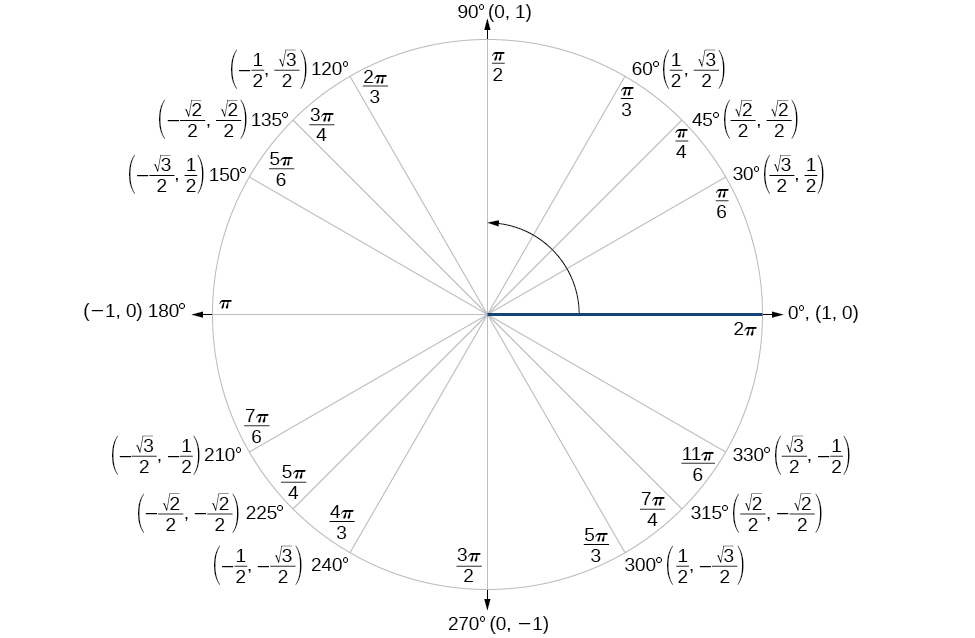
Sum-Difference Identities
Cosine
$\cos(A\pm B)=\cos (A)\cos (B)\mp\sin (A)\sin (B)$
If you aren’t familiar with $\mp,$ it works like this:
- If the $\pm$ is a plus, then the $\mp$ is a minus
- If the $\pm$ is a minus, then the $\mp$ is a plus So the cosine rule can be broken into 2 parts:
$\cos(A+B)=\cos (A)\cos (B)-\sin (A)\sin (B)$
$\text{and}$
$\cos(A-B)=\cos (A)\cos (B)+\sin (A)\sin (B)$
$\newcommand{\nl}[0]{}$
Proof for cosine sum-difference identity
- Consider 2 points ($P$ and $Q$) on the unit circle:
- Point $P$ is at an angle $\alpha$ from the positive x-axis with coordinates $(\sin (\alpha), \cos(\alpha))$
- Point $Q$ is at an angle of $\beta$ from the positive x-axis, with coordinates $(\sin (\beta), \cos(\beta))$
- In this triangle, $\angle POQ$ will be $\alpha - \beta$
If this hard to visualise, a diagram is coming.
- Let’s make another triangle:
- Point $A$ is located at an angle of $(\alpha-\beta)$ from the positive x-axis, and has coordinates $(\cos(\alpha-\beta),\sin(\alpha-\beta))$
- Point $B$ is located at $(1,0)$
- If you’ve drawn out the 2 triangles, you will have noticed that $\triangle AOB$ and $\triangle POQ$ are rotations of each other, and are therefore congruent, so we can say that $PQ$ and $AB$ are equal
$$\text{Mathematically: }\triangle AOB\cong\triangle POQ,\therefore PQ=AB$$
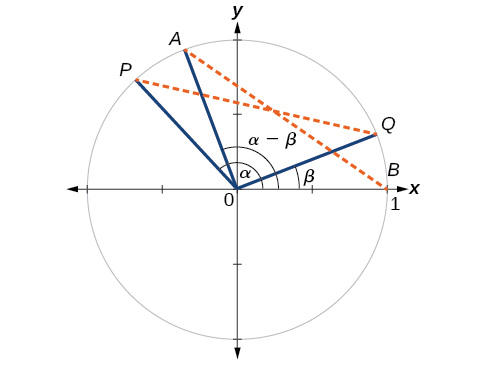
If you don’t remember the Cartesian distance formula, here it is:
$d=\sqrt{(x_2-x_1)^2 +(y_2-y_1)^2}$
- Now, we can find the distance from $P$ to $Q$ using the Cartesian distance formula: $$d_{PQ}= \sqrt{{(cos \alpha - cos \beta )}^2+{(sin \alpha - sin \beta )}^2}$$ $$= \sqrt{{\cos}^2 \alpha-2\cos \alpha \cos \beta+{\cos}^2 \beta+{\sin}^2 \alpha-2\sin \alpha \sin \beta+{\sin}^2 \beta}\qquad $$ $$\text {Apply Pythagorean identity and simplify.}$$ $$= \sqrt{({\cos}^2 \alpha+{\sin}^2 \alpha)+({\cos}^2 \beta+{\sin}^2 \beta)-2\cos \alpha \cos \beta-2\sin \alpha \sin \beta}$$ $$= \sqrt{1+1-2\cos \alpha \cos \beta-2\sin \alpha \sin \beta}$$ $$= \sqrt{2-2\cos \alpha \cos \beta-2\sin \alpha \sin \beta}\qquad$$ $$\text {Similarly, using the distance formula we can find the distance from A to B.}$$ $$d_{AB} = \sqrt{{(\cos(\alpha-\beta)-1)}^2+{(\sin(\alpha-\beta)-0)}^2}$$ $$= \sqrt{{\cos}^2(\alpha-\beta)-2\cos(\alpha-\beta)+1+{\sin}^2(\alpha-\beta)}\qquad$$ $$\text {Apply Pythagorean identity and simplify}$$ $$= \sqrt{({\cos}^2(\alpha-\beta)+{\sin}^2(\alpha-\beta))-2\cos(\alpha-\beta)+1}$$ $$= \sqrt{1-2\cos(\alpha-\beta)+1}$$ $$= \sqrt{2-2\cos(\alpha-\beta)}\qquad$$ $$\text {Subtract 2 from both sides and divide both sides by −2.}$$ $$\cos \alpha \cos \beta+\sin \alpha \sin \beta = \cos(\alpha-\beta)$$
Sine
$sin(A\pm B)=\sin A\cos B\pm \cos A \sin B$
Proof for sine sum-difference identity
- Substitute $90°-A$ for $A$ in the cosine sum-difference formula:
- $\cos((90°-A)\pm B)=\cos(90°-A)\cos(B)\mp\sin(90°-A)\sin(B)$
- $\text{Using }\sin(\theta)=\cos(90°-\theta), \cos(90°-(A\pm B))=\sin(A\pm B)$
- $=\sin(A)\cos(B)\pm\cos(A)\sin(B)$
- $\therefore\sin(A\pm B)=\sin(A)\cos(B)\pm\cos(A)\sin(B)$
Tangent
$\tan(A\pm B)=\frac{\sin(A\pm B)}{\cos(A\pm B)}=\frac{\tan(A)\pm \tan(B)}{1\mp\tan(A)tan(B)}$
Proof for tangent sum-difference identity
Honestly I’m not bothered to do it. I’ll probably get carpal tunnel syndrome from all these escape characters.
To prove it yourself, just use $tan\theta =\frac{sin\theta}{cos\theta},$ sub in the $\sin$ and $\cos$ identities, and simplify. It’s not that hard, its just tedious 😕.
Double Angle Identities
Sine
$\sin(2A)=2\sin(A)\cos(A)$
Proof
$sin(2A)=sin(A+A)$
$=sin A cos A + cos A sin A$
$=2 sin A cos A$
Cosine
$cos 2A=cos^2 A-sin^2 A$
Proof
$cos(2A)=cos(A+A)$
$=cos A cos A-sin A sin A$
$=cos^2 A-sin^2 A$
Tangent
$tan(2A)=\frac{2\tan(A)}{1-\tan^2 (A)}$
Proof
$\tan(2A)=\tan(A+A)$
$=\frac{\tan(A)+\tan(A)}{1-\tan(A)\tan(A)}$
$=\frac{2\tan(A)}{1-\tan^2 (A)}$
Product Identities
- These are just the sum-difference identities, rearranged to find the products of the ratios.
This means I don’t have to do proofs! Yay!
Cosine-Cosine
$cos(A)cos(B)=\frac{1}{2}[cos(A+B)+cos(A-B)]$
Sine-Sine
$sin(A)sin(B)=\frac{1}{2}[cos(A-B)+cos(A+B)]$
Sine-Cosine
$sin(A)cos(B)=\frac{1}{2}[sin(A+B)+sin(A-B)]$
Cosine-Sine
$cos(A)sin(B)=\frac{1}{2}[sin(A+B)-sin(A-B)]$
T-Formulae
$t=tan(\frac{A}{2})$
I’m not even bothered to type proofs anymore. Y’all can deal with screenshots.
- $sin A=\frac{2t}{1+t^2}$
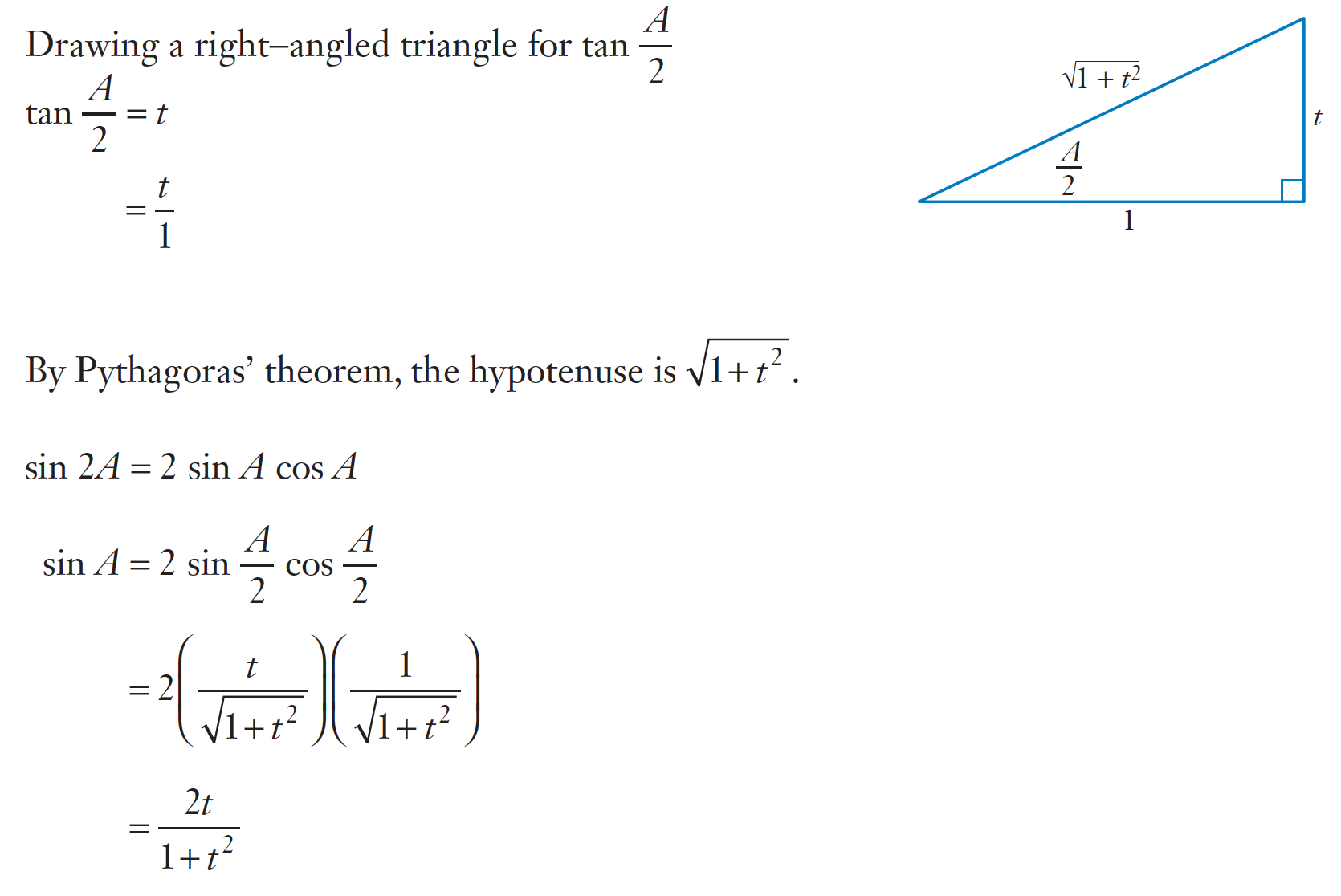
- $cos A=\frac{1-t^2}{1+t^2}$
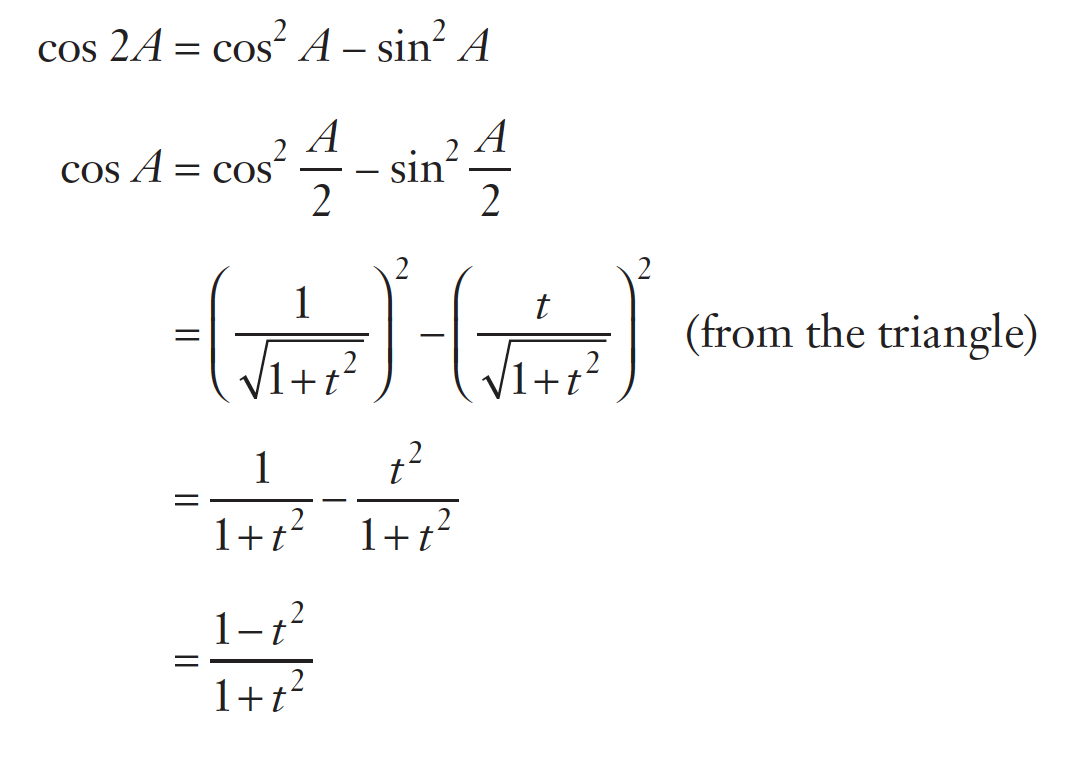
- $tan A=\frac{2t}{1-t^2}$
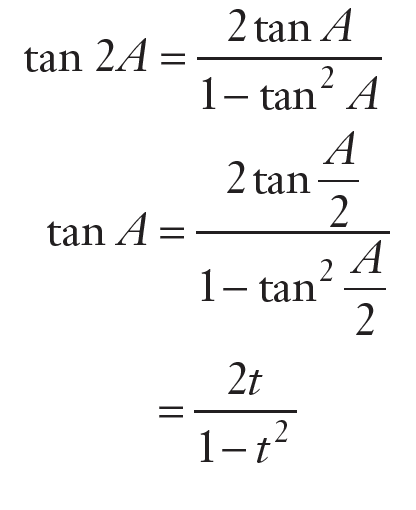
Inverse Trigonometric Functions
Notation
Inverse trigonometric functions are notated in one of 2 ways:
- The “arc” prefix:
- $arcsin(x)$
- $arccos(x)$
- $arctan(x)$
- $arcsec(x)$
- $arccosec(x)/arccsc(x)$
- $arccot(x)$
- The inverse $(^{-1})$ notation:
- $sin^{-1}(x)$
- $cos^{-1}(x)$
- $tan^{-1}(x)$
- $sec^{-1}(x)$
- $cosec^{-1}(x)/csc^{-1}(x)$
- $cot^{-1}(x)$
The value of the inverse of an inverse trigonometric function is the original value.
For example:
$sin(sin^{-1}(x))=x$
This is true for all inverse trigonometric functions.
$y=\sin^{-1}(x)$
$y=\cos^{-1}(x)$
$y=\tan^{-1}(x)$
Properties
- $\sin^{-1}(-x)=-\sin^{-1}(x)$
- $cos^{−1}(−x)=\pi−cos^{−1}(x)$
- $tan^{−1}(−x)=−tan^{−1}(x)$
- $sin^{−1}(x)+cos^{−1}(x)=\frac{\pi}{2}$
And we’re done!
That’s all of Extension 1 Trigonometry (for year 11, anyway).
References
Abramson, J. (2015, October 31). 7.3: Sum and Difference Identities - Mathematics LibreTexts. Mathematics LibreTexts; OpenStax CNX. https://math.libretexts.org/Bookshelves/Precalculus/Book%3A_Precalculus_(OpenStax)/07%3A_Trigonometric_Identities_and_Equations/7.03%3A_Sum_and_Difference_Identities ↩︎